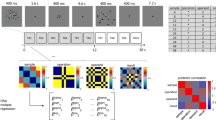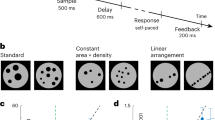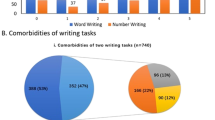Abstract
A popular metaphor for the representation of numbers in the brain is the 'mental number line', in which numbers are represented in a continuous, quantity-based analogical format1,2. Here we show that patients with hemispatial neglect3 misplace the midpoint of a numerical interval when asked to bisect it (for example, stating that five is halfway between two and six), with an error pattern that closely resembles the bisection of physical lines4. This new form of representational neglect constitutes strong evidence that the mental number line is more than simply a metaphor, and that its spatial nature renders it functionally isomorphic to physical lines.
This is a preview of subscription content, access via your institution
Access options
Subscribe to this journal
Receive 51 print issues and online access
$199.00 per year
only $3.90 per issue
Buy this article
- Purchase on Springer Link
- Instant access to full article PDF
Prices may be subject to local taxes which are calculated during checkout

Similar content being viewed by others
References
Restle, F. J. Exp. Psychol. 83, 274–278 (1970).
Dehaene, S., Dupoux, E. & Mehler, J. J. Exp. Psychol. Hum. Percept. Perform. 16, 626–641 (1990).
Bisiach, E. & Vallar, G. in Handbook of Neuropsychology (eds Boller, F. & Grafman, G.) 459–502 (Elsevier, Amsterdam, 2000).
Marshall, J. & Halligan, P. Cortex 25, 503–515 (1989).
Seron, X., Pesenti, M., Noël, M. P., Deloche, G. & Cornet, J. A. Cognition 44, 159–196 (1992).
Dehaene, S., Bossini, S. & Giraux, P. J. Exp. Psychol. Gen. 122, 371–396 (1993).
Moyer, R. & Landauer, T. Nature 215, 1519–1520 (1967).
Brannon, E. & Terrace, H. Science 282, 746–749 (1998).
Bächtold, D., Baumüller, M. & Brugger, P. Neuropsychologia 36, 731–735 (1998).
Dehaene, S., Dehaene-Lambertz, G. & Cohen, L. Trends Neurosci. 21, 355–361 (1998).
Caramazza, A. & Hillis, A. E. Nature 346, 267–269 (1990).
Dehaene, S. & Cohen, L. Cortex 33, 219–250 (1997).
Hadamard, J. The Mathematician's Mind: The Psychology of Invention in the Mathematical Field (Princeton Univ. Press, New Jersey, 1996).
Author information
Authors and Affiliations
Corresponding author
Ethics declarations
Competing interests
The authors declare no competing financial interests.
Rights and permissions
About this article
Cite this article
Zorzi, M., Priftis, K. & Umiltà, C. Neglect disrupts the mental number line. Nature 417, 138–139 (2002). https://doi.org/10.1038/417138a
Issue Date:
DOI: https://doi.org/10.1038/417138a
This article is cited by
-
From vision to cognition: potential contributions of cerebral visual impairment to neurodevelopmental disorders
Journal of Neural Transmission (2023)
-
The link between number and action in human infants
Scientific Reports (2022)
-
The contribution of attentional processes to calculation skills in second and third grade in a typically developing sample
European Journal of Psychology of Education (2021)
-
SNARC effect modulated by central executive control: revealed in a cue-based trisection task
Psychological Research (2021)
-
Fostering number sense in low SES children: a comparison between low- and high-intensity interventions
Mathematics Education Research Journal (2021)
Comments
By submitting a comment you agree to abide by our Terms and Community Guidelines. If you find something abusive or that does not comply with our terms or guidelines please flag it as inappropriate.



